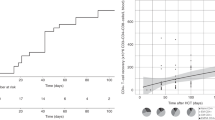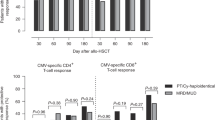Abstract
Growth factor-mobilized peripheral blood stem cells (PBSCs) engraft rapidly in myeloablated recipients compared to conventional BM, but this procedure also mobilizes mature lymphocytes and monocytes which can impact immune reconstitution and GVHD. Hence, we serially evaluated immune reconstitution and cytokine expression in PBSCT recipients in the first year. Engraftment of neutrophils and monocytes stabilized early but NK cells, B cells and CD4+ T cell numbers were significantly (P < 0.05) low with persistently reversed cd4:cd8 ratios. nk function remained low throughout the first year. the quantitative decrease in cd4+ T cells resulted in significantly decreased proliferation in response to mitogens and alloHLA antigens. Yet, a qualitative analysis of T cell function measured by Ca++ influx after T cell activation with antiCD3 as well as T-dependent polyclonal Ig secretion by mitogen-stimulated B cells was preserved even early post transplant. TNFα mRNA was detected in almost all recipients in the first year. IL-10 mRNA was detected in 77%, IL-2 in 22% and IFNγ in 44% of recipients in the first 6 months. Only 30% expressed IL-10 in the second 6 months post transplant while expression of IL-2 and IFNγ was detected in 38% and 46% respectively. Thirty-seven percent of PBSCT recipients developed grades II–IV acute GVHD but 72% went on to develop chronic extensive GVHD at a median of 120 days. Sixty-two percent developed CMV viremia and 5.4% developed overt CMV disease in the first year post PBSCT. Lymphocyte engraftment is quantitatively delayed but CD4 functions are preserved while NK numbers and function are compromised post PBSCT. IL-10 expression decreases after the first 6 months post transplant while TNFα is continually expressed. The balance between quantitative lymphocyte reconstitution and qualitative lymphocyte functions as well as changes in lymphokine patterns may influence infection and GVHD and thus the clinical outcome post PBSCT.
This is a preview of subscription content, access via your institution
Access options
Subscribe to this journal
Receive 12 print issues and online access
$259.00 per year
only $21.58 per issue
Buy this article
- Purchase on Springer Link
- Instant access to full article PDF
Prices may be subject to local taxes which are calculated during checkout
Similar content being viewed by others
Author information
Authors and Affiliations
Rights and permissions
About this article
Cite this article
Shenoy, S., Mohanakumar, T., Todd, G. et al. Immune reconstitution following allogeneic peripheral blood stem cell transplants. Bone Marrow Transplant 23, 335–346 (1999). https://doi.org/10.1038/sj.bmt.1701581
Received:
Accepted:
Published:
Issue Date:
DOI: https://doi.org/10.1038/sj.bmt.1701581
Keywords
This article is cited by
-
Patients’ NK cell stimulation with activated plasmacytoid dendritic cells increases dinutuximab-induced neuroblastoma killing
Cancer Immunology, Immunotherapy (2020)
-
Increased bone marrow CD56bright natural killer cells at 30 days after allogeneic stem cell transplantation associated with adverse patient outcome
Bone Marrow Transplantation (2019)
-
Polyclonal gammopathy after BKV infection in HSCT recipient: a novel trigger for plasma cells replication?
Virology Journal (2015)
-
Virus infection in HLA-haploidentical hematopoietic stem cell transplantation: incidence in the context of immune recovery in two different transplantation settings
Annals of Hematology (2015)
-
CD4+ T cell counts reflect the immunosuppressive state of CD4 helper cells in patients after allogeneic stem cell transplantation
Annals of Hematology (2015)



